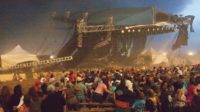The first-ever environmental hazard load-resistance requirements tailored specifically to public-occupancy temporary structures, such as outdoor stages and tents, are on their way to becoming part of the 2024 edition of the model International Building Code.
A group of structural engineers led a six-year effort to modify the code, motivated by concern about life safety, inconsistent or nonexistent building code enforcement and a lack of appropriate design guidance for the temporary structures.
The International Code Council recently posted the preliminary results—approved as modified by public comment—of the online balloting for code-change proposal S116-22, which was approved in September at its public comment hearings in Louisville, Ky.
“We posted the preliminary results pending validation of the online voting,” says Lawrence Novak, ICC chief structural engineer for codes and standards development.
He cautions that the vote is not final until it is certified by the group's validation committee and confirmed by its board of directors.
An all-volunteer ad hoc council committee developed S116-22 because building officials have no uniform or consistent approach to grant permits for public-occupancy temporary structures, which usually fall under the purview of the fire marshal and the fire code, not the department of buildings.
The need for improved and consistent structural regulation across the U.S. for environmental hazards such as wind, snow, floods and earthquakes became apparent to many building officials and structural engineers in 2011, when there were three temporary-structure failures, including that of a rock concert stage at the Indiana State Fairgrounds that killed seven people.
The revised S116-22 is on course to drastically modify International Building Code chapters 31 and 16. The model code currently calls for designing temporary structures to the same load standard as permanent structures, which engineers say is overkill. In addition, the provisions are rarely if ever enforced, say building officials.
The proposal defines public-occupancy temporary structures as new buildings or structures that are used by the general public, or that support public events, for which the public expects similar levels of reliability and safety offered by permanent construction. Public-occupancy temporary structures are often assembled with reusable components that are disassembled and shipped to another event for reassembly. They are designed for a particular purpose and a specific period of time, which the proposal defines as less than one year.
Original Proposal Modified
The latest voting approved the proposal based on modifications to the original S116-22, offered as four public comments by structural engineer Jon Siu, a code consultant and recently retired Seattle building official. With the proposal revised to include his comments, he voted for S116-22.
One of Siu’s main changes from the original proposal, released for public comment last spring, was to shift the responsibility from the building official to the owner for post-certificate of occupancy (CO) inspections and reports.
S116-22 now states that a "qualified person" needs to provide these inspections, borrowing a term used in other parts of the proposal, says Siu. The records have to be available to the building official, and be submitted to them along with any request for an extension of the CO.
Another modification clarifies how to determine the risk category, and therefore the importance factors, for temporary nonbuilding structures that are associated with or ancillary to public assemblies or special events structures, says Siu. Examples of these ancillary structures are temporary speaker stands or camera stands used for temporary outdoor events.
Still another change focuses on clarifying the provisions around how to handle situations where public-occupancy temporary structures are not, or cannot be, designed for the full required loads, explains Siu.
One example: a large tent-like temporary structure in a tsunami hazard zone. “There is no way it can be designed for tsunamis,” says Siu. In these cases, the owner has to implement "controlled occupancy procedures," based on a pre-approved action plan for an emergency, which is required to be documented for a permit.
“Jon’s comments were cleanups to the [original] proposal to make it more palatable to the building official and consistent with what they do to implement” the codes, but the technical content did not change, says Don Scott, chair of the ICC ad-hoc committee that wrote the proposal. “Jon worked hand-in-hand with the committee on the comments to make sure everyone was on the same page.”
There is more work to be done. Assuming the proposal is validated, there will be a disconnect between the requirements of the 2024 IBC and the 2024 International Fire Code, which was developed earlier. The two will be aligned in the 2027 code cycle, by the same committee.
“We didn’t have time to modify the fire code for 2024,” says Scott.
In addition, the ICC ad hoc committee, composed of members of the main committee for the 2028 edition of the American Society of Civil Engineers’ Structural Engineering Institute’s Minimum Design Loads and Associated Criteria for Buildings and Other Structures (ASCE/SEI 7), is gearing up to turn the IBC provisions into ASCE's first-ever consensus standard for public-occupancy temporary structures. “The provisions are 70% to 80% ready" for ASCE/SEI 7-28, says Scott.





Post a comment to this article
Report Abusive Comment